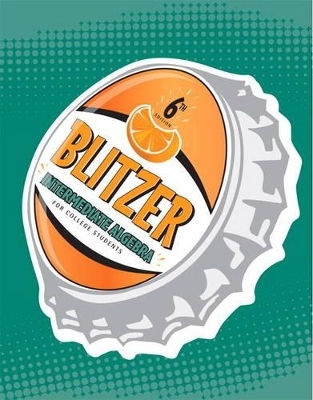
Intermediate Algebra for College Students Plus NEW MyMathLab with Pearson eText -- Access Card Package
Pearson
978-0-321-72929-3 (ISBN)
- Titel erscheint in neuer Auflage
- Artikel merken
Packages
Access codes for Pearson's MyLab & Mastering products may not be included when purchasing or renting from companies other than Pearson; check with the seller before completing your purchase.
Used or rental books
If you rent or purchase a used book with an access code, the access code may have been redeemed previously and you may have to purchase a new access code.
Access codes
Access codes that are purchased from sellers other than Pearson carry a higher risk of being either the wrong ISBN or a previously redeemed code. Check with the seller prior to purchase.
-- The Blitzer Algebra Series combines mathematical accuracy with an engaging, friendly, and often fun presentation for maximum appeal. Blitzer’s personality shows in his writing, as he draws readers into the material through relevant and thought-provoking applications. Every Blitzer page is interesting and relevant, ensuring that students will actually use their textbook to achieve success!
Bob Blitzer is a native of Manhattan and received a Bachelor of Arts degree with dual majors in mathematics and psychology (minor: English literature) from the City College of New York. His unusual combination of academic interests led him toward a Master of Arts in mathematics from the University of Miami and a doctorate in behavioral sciences from Nova University. Bob’s love for teaching mathematics was nourished for nearly 30 years at Miami Dade College, where he received numerous teaching awards, including Innovator of the Year from the League for Innovations in the Community College and an endowed chair based on excellence in the classroom. In addition to his Developmental Algebra Series, Bob has written textbooks covering college algebra, algebra and trigonometry, precalculus, and liberal arts mathematics, all published by Pearson Education. When not secluded in his Northern California writer’s cabin, Bob can be found hiking the beaches and trails of Point Reyes National Seashore, and tending to the chores required by his beloved entourage of horses, chickens, and irritable roosters.
1. Algebra, Mathematical Models, and Problem Solving
1.1 Algebraic Expressions, Real Numbers, and Interval Notation
1.2 Operations with Real Numbers and Simplifying Algebraic Expressions
1.3 Graphing Equations
1.4 Solving Linear Equations
Mid-Chapter Check Point Section 1.1–Section 1.4
1.5 Problem Solving and Using Formulas
1.6 Properties of Integral Exponents
1.7 Scientific Notation
Chapter 1 Group Project
Chapter 1 Summary
Chapter 1 Review Exercises
Chapter 1 Test
2. Functions and Linear Functions
2.1 Introduction to Functions
2.2 Graphs of Functions
2.3 The Algebra of Functions
Mid-Chapter Check Point Section 2.1–Section 2.3
2.4 Linear Functions and Slope
2.5 The Point-Slope Form of the Equation of a Line
Chapter 2 Group Project
Chapter 2 Summary
Chapter 2 Review Exercises
Chapter 2 Test
Cumulative Review Exercises (Chapters 1–2)
3. Systems of Linear Equations
3.1 Systems of Linear Equations in Two Variables
3.2 Problem Solving and Business Applications Using Systems of Equations
3.3 Systems of Linear Equations in Three Variables
Mid-Chapter Check Point Section 3.1–Section 3.3
3.4 Matrix Solutions to Linear Systems
3.5 Determinants and Cramer's Rule
Chapter 3 Group Project
Chapter 3 Summary
Chapter 3 Review Exercises
Chapter 3 Test
Cumulative Review Exercises (Chapters 1–3)
4. Inequalities and Problem Solving
4.1 Solving Linear Inequalities
4.2 Compound Inequalities
4.3 Equations and Inequalities Involving Absolute Value
Mid-Chapter Check Point Section 4.1–Section 4.3
4.4 Linear Inequalities in Two Variables
4.5 Linear Programming
Chapter 4 Group Project
Chapter 4 Summary
Chapter 4 Review Exercises
Chapter 4 Test
Cumulative Review Exercises (Chapters 1–4)
5. Polynomials, Polynomial Functions, and Factoring
5.1 Introduction to Polynomials and Polynomial Functions
5.2 Multiplication of Polynomials
5.3 Greatest Common Factors and Factoring By Grouping
5.4 Factoring Trinomials
Mid-Chapter Check Point Section 5.1–Section 5.4
5.5 Factoring Special Forms
5.6 A General Factoring Strategy
5.7 Polynomial Equations and Their Applications
Chapter 5 Group Project
Chapter 5 Summary
Chapter 5 Review Exercises
Chapter 5 Test
Cumulative Review Exercises (Chapters 1–5)
6. Rational Expressions, Functions, and Equations
6.1 Rational Expressions and Functions: Multiplying and Dividing
6.2 Adding and Subtracting Rational Expressions
6.3 Complex Rational Expressions
6.4 Division of Polynomials
Mid-Chapter Check Point Section 6.1–Section 6.4
6.5 Synthetic Division and the Remainder Theorem
6.6 Rational Equations
6.7 Formulas and Applications of Rational Equations
6.8 Modeling Using Variation
Chapter 6 Group Project
Chapter 6 Summary
Chapter 6 Review Exercises
Chapter 6 Test
Cumulative Review Exercises (Chapters 1–6)
7. Radicals, Radical Functions, and Rational Exponents
7.1 Radical Expressions and Functions
7.2 Rational Exponents
7.3 Multiplying and Simplifying Radical Expressions
7.4 Adding, Subtracting, and Dividing Radical Expressions
Mid-Chapter Check Point Section 7.1–Section 7.4
7.5 Multiplying with More Than One Term and Rationalizing Denominators
7.6 Radical Equations
7.7 Complex Numbers
Chapter 7 Group Project
Chapter 7 Summary
Chapter 7 Review Exercises
Chapter 7 Test
Cumulative Review Exercises (Chapters 1–7)
8. Quadratic Equations and Functions
8.1 The Square Root Property and Completing the Square
8.2 The Quadratic Formula
8.3 Quadratic Functions and Their Graphs
Mid-Chapter Check Point Section 8.1–Section 8.3
8.4 Equations Quadratic in Form
8.5 Polynomial and Rational Inequalities
Chapter 8 Group Project
Chapter 8 Summary
Chapter 8 Review Exercises
Chapter 8 Test
Cumulative Review Exercises (Chapters 1–8)
9. Exponential and Logarithmic Functions
9.1 Exponential Functions
9.2 Composite and Inverse Functions
9.3 Logarithmic Functions
9.4 Properties of Logarithms
Mid-Chapter Check Point Section 9.1–Section 9.4
9.5 Exponential and Logarithmic Equations
9.6 Exponential Growth and Decay; Modeling Data
Chapter 9 Group Project
Chapter 9 Summary
Chapter 9 Review Exercises
Chapter 9 Test
Cumulative Review Exercises (Chapters 1–9)
10. Conic Sections and Systems of Nonlinear Equations
10.1 Distance and Midpoint Formulas; Circles
10.2 The Ellipse
10.3 The Hyperbola
Mid-Chapter Check Point Section 10.1–Section 10.3
10.4 The Parabola; Identifying Conic Sections
10.5 Systems of Nonlinear Equations in Two Variables
Chapter 10 Group Project
Chapter 10 Summary
Chapter 10 Review Exercises
Chapter 10 Test
Cumulative Review Exercises (Chapters 1–10)
11. Sequences, Series, and the Binomial Theorem
11.1 Sequences and Summation Notation
11.2 Arithmetic Sequences
11.3 Geometric Sequences and Series
Mid-Chapter Check Point Section 11.1–Section 11.3
11.4 The Binomial Theorem
Chapter 11 Group Project
Chapter 11 Summary
Chapter 11 Review Exercises
Chapter 11 Test
Cumulative Review Exercises (Chapters 1–11)
Appendix
Where Did That Come From? Selected Proofs
| Erscheint lt. Verlag | 29.2.2012 |
|---|---|
| Sprache | englisch |
| Gewicht | 2087 g |
| Themenwelt | Mathematik / Informatik ► Mathematik ► Algebra |
| ISBN-10 | 0-321-72929-3 / 0321729293 |
| ISBN-13 | 978-0-321-72929-3 / 9780321729293 |
| Zustand | Neuware |
| Informationen gemäß Produktsicherheitsverordnung (GPSR) | |
| Haben Sie eine Frage zum Produkt? |
aus dem Bereich

